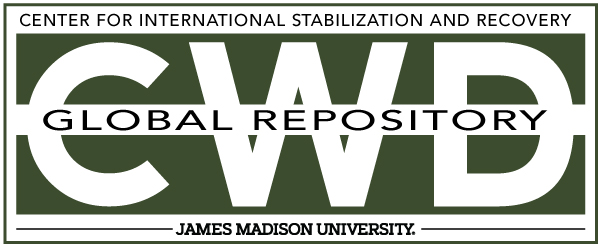Document Type
Other
Creative Commons License

This work is licensed under a Creative Commons Attribution-Noncommercial-No Derivative Works 4.0 License.
Publication Date
9-2002
Keywords
TWEIS, 2002, 4th Edition, Risk Education, Victim Assistance, ERW Clearance, Conventional Weapons Stockpile Destruction, Advocacy and International Law, Centers and Organizations, State Department, Humanitarian Mine Action, Landmine, Clearance, Victim Assistance, Risk Education, Funding, PM/WRA, MANPADS, HMA, Training, Research, Development, PSSM, CISR
Abstract
By the end of 2002, the United States will have provided more than $600,000,000 to 43 countries, as well as to northwest Somalia, for various humanitarian demining efforts, such as deminer training, mine awareness and mine clearance, orthopedic assistance to, and socioeconomic reintegration programs for, landmine accident survivors and their families. More than $100,000,000 of this total was spent in Fiscal Year 2002, one of the largest commitments of any nation involved in financing humanitarian demining activities.
The goals of the U.S. Humanitarian Demining Program are simple and direct: to reduce the loss of life and limb of innocents; to create conditions for the safe return of refugees and internally displaced persons; and to afford opportunity for economic and social reconstruction. Our principal means of achieving these objectives is to assist all mine-afflicted countries in establishing a sustainable, indigenous demining capacity with the appropriate resourcesand skills needed to sustain that degree of progressthat allows a country to declare itself mine-safe.
This, the fourth edition of To Walk the Earth in Safety:The United States Commitment to HumanitarianDemining, tells the U.S. story, but not the wholestory. Foreign governments, the United Nations,other international and non-governmental organizations,and mine-affected countries also play a critical role in supporting humanitarian demining programs.The impact of these collective contributions has already been felt in many of these countries. In the near future several countries will be able to declare themselves mine-safe, while many other countries are even now capable of sustaining their own mineaction activities. Hundreds of thousands of refugees and internally displaced persons have returned to their homes. Tens of thousands of acres of land formerly fallow because of the presence of landmines are now burgeoning with agricultural produce necessary to sustain life. Roads to marketplaces are now open; access to potable water is once more available; previously empty schools again are the centers of learning for the nations’ young.
Included in
Defense and Security Studies Commons, Peace and Conflict Studies Commons, Public Policy Commons, Social Policy Commons



